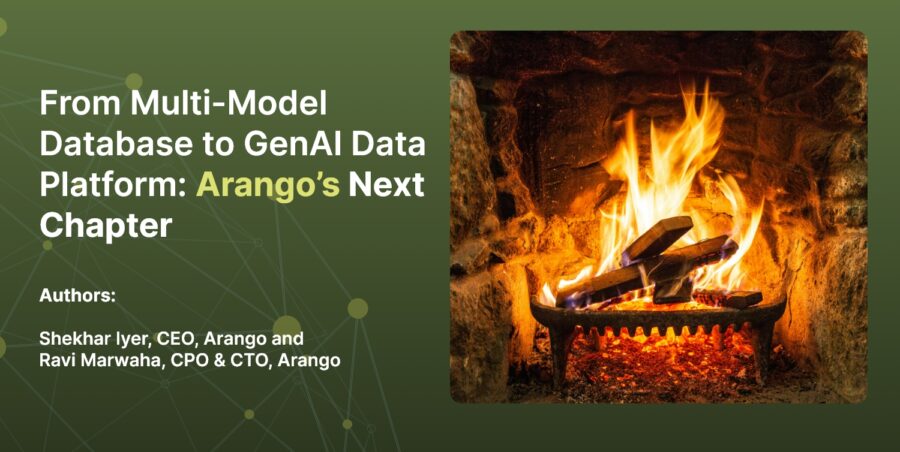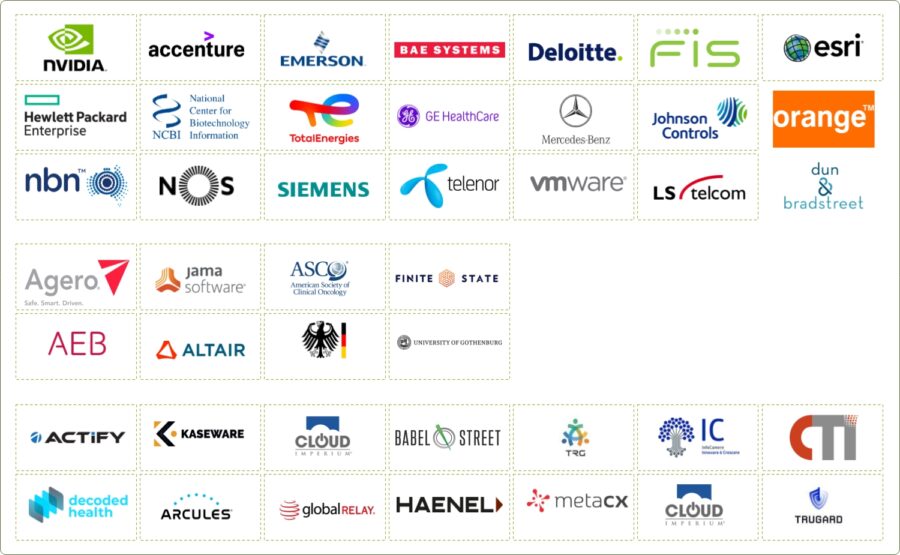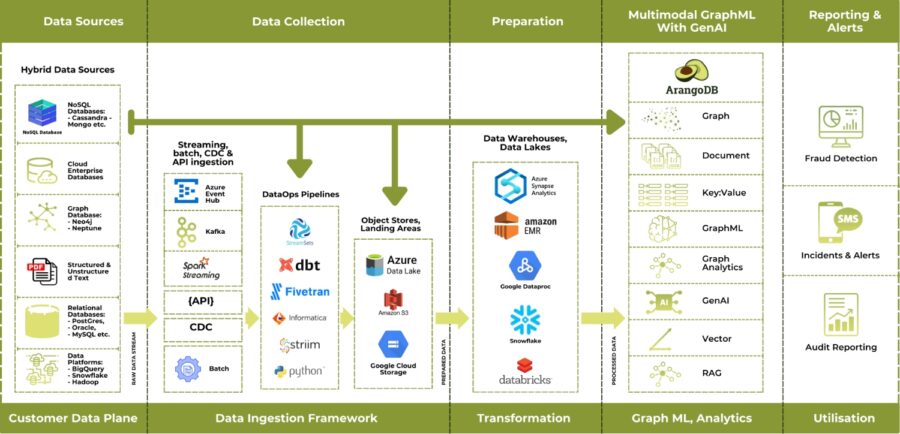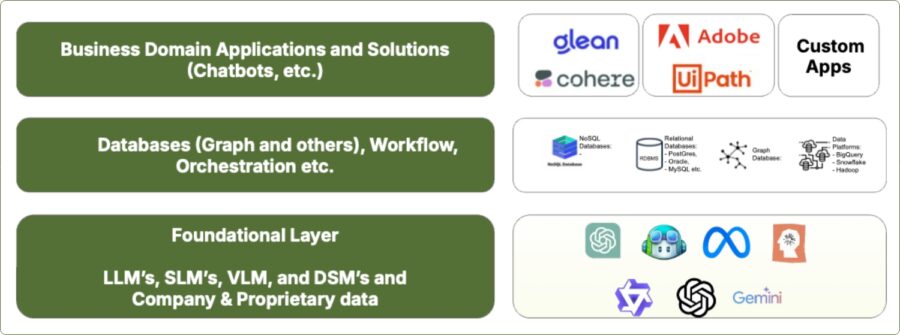From Native Multi-Model Graph Database to GenAI Data Platform: Arango’s Next Chapter
Authors:
Shekhar Iyer, CEO, Arango and Ravi Marwaha, CPO & CTO, Arango

A New Chapter for Arango
In this webinar we explored Arango’s next chapter evolving from a multi-model database into a GenAI data platform built for speed, scale, and flexibility.
For over a decade, Arango has been known as the most scalable, lowest TCO and developer friendly/Application friendly multi-model graph database. But the world has changed, and we can all thank ChatGPT 2022 for that..
“Just like the internet reshaped every industry 30 years ago, GenAI will redefine how businesses operate in the next decade.”
– Shekhar Iyer
GenAI is no longer a buzzword it’s reshaping how enterprises, startups, and innovators design applications. With this shift comes new requirements:
- Managing structured and unstructured data together,
- Unifying search and vector queries,
- Scaling without compromise, and
- Delivering results at the speed business demands.
That’s the transformation we’re leading.
 Proven success with large and medium enterprises globally
Proven success with large and medium enterprises globally
Why This Matters Now
Every technology wave comes with skepticism. In the 1990s, people debated whether the internet was hype or reality. Today, nobody doubts its impact. GenAI is at the same inflection point.
But here’s the challenge: 95% of GenAI projects fail (MIT study). The reasons?
- Data silos delay progress.
- Fragile integrations break under load.
- Legacy infrastructure can’t scale to the needs of LLMs and agentic AI.
Customers from the world’s largest enterprises like NVIDIA and HPE to fast-moving startups tell us they need something different. They need a unified foundation.
 ArangoDB : Data Lifecycle & Data Architecture
ArangoDB : Data Lifecycle & Data Architecture
“If we only talk about bits and bytes, we’ve missed the point our goal is accelerating business value.”
– Shekhar Iyer
At Arango, we believe the answer lies in 3 core principles:
- Simplicity: Natively multi-model, supporting vector, graph, search, document, and key-value.
- Scalability: Horizontally and vertically, with GPU acceleration built in.
- Deployment Flexibility: On-prem, embedded, or cloud with cost-effective, enterprise-ready models.
 Key Differentiation & Value
Key Differentiation & Value
Solving Complexity with One Unified Platform
For developers and architects, the reality of building GenAI apps today is daunting. You’re stitching together SQL, NoSQL, graph, and vector databases all scaling differently, each with its own APIs and languages. That’s fragile, costly, and slow. With Arango GenAI data platform, we want to increase your developer productivity to 10x and increase your speed to market by 10x and we plan to continually work with you to make that possible.
Arango takes a different approach. From day one, we built a native multi-model database. Today, that foundation means we can unify:
- Vector search for embeddings
- Graph for context and relationships
- Document & key-value for flexibility
- Search for discoverability
- Time-travel queries for history and compliance
- GPU acceleration for scale
- All in a single engine, through one query language
- Various tools/Frameworks/GenAI toolsets/MCPs/Agentic workflow
“If you try to stitch together SQL, NoSQL, vector, graph, and search, along with various tools, MCPs, Frameworks, data pipelines, and be able to maintain, build observability, scalability, you’re managing 20 or so different pieces of technologies that all scale differently. With Arango, it’s unified in one Platform.”
– Ravi Marwaha
 A Simplistic Agentic Data Infrastructure (Middle Layer)
A Simplistic Agentic Data Infrastructure (Middle Layer)
Introducing the GenAI Suite
We’re also unveiling our GenAI Suite designed to accelerate projects whether you’re building:
- Chatbots and copilots for employees or customers
- Front-office and back-office automation powered by GraphRAG and LLMs
- Agentic workflows that bring intelligence into everyday processes
With prebuilt integrations, GraphRAG blueprints, and support for LLMs and domain-specific models, the GenAI Suite reduces the burden of wiring everything together so you can focus on building value.
“Complexity kills ROI. GenAI projects fail when the data isn’t ready, the tools aren’t integrated, and the systems don’t scale and you can’t maintain or manage upgrades and changes.”
– Ravi Marwaha
Deployment on Your Terms
Flexibility doesn’t stop at the data model or how many pieces of technology teams have to stitch together. Arango offers multiple deployment options on-prem, embedded in your stack, or fully managed in the cloud all accessible through a single unified interface.
That means whether you’re a startup with a clean slate or a global enterprise with legacy systems, or a startup building a net new application, you can plug Arango into your environment without the integration nightmare and enable scenarios and capabilities that are at least 10x more challenging with Relational database approaches.
Why We’re Excited
“Simplify, scale, and speed-to-value that’s the mission behind Arango’s evolution into a GenAI data platform.”
– Shekhar Iyer
 Why Arango?
Why Arango?
This is more than a product evolution. It’s about enabling enterprises and innovators to succeed where others fail to move from experimentation to production faster, with less risk, and with greater impact.
For our existing customers who know us for our best-in-class graph capabilities, we’re expanding to meet your GenAI needs. For developers and architects exploring the space: this is your chance to build on a unified, enterprise-ready foundation.
Watch the Replay & Connect With Us
This blog is just the beginning.


From Sensor Noise to Strategic Insights: How ArangoDB and GraphRAG are Reinventing IoT for Smart Manufacturing
Estimated reading time: 7 minutes
The modern manufacturing floor hums not just with machines, but with data as well. From predictive maintenance and energy monitoring to quality control and supply chain automation, IoT devices now generate terabytes of time-series and event data on a daily basis.
But here’s the reality: Most of that data goes underutilized. Why? Because traditional relational databases, and even some NoSQL systems such as MongoDB, are simply not built to connect the dots across time, entities, processes, and semantic context.
This is where ArangoDB’s native multi-model architecture combined with the emerging power of GraphRAG (Graph + Retrieval Augmented Generation) changes the game.
The Challenge: Semantic Search in a Sea of Machines
Imagine a factory that produces advanced electric vehicles. Each car part travels through dozens of IoT-connected stations, generating logs about:
- Sensor readings (vibration, temperature, torque)
- Operator interactions
- Machine health stats
- Maintenance flags
- Real-time energy consumption
The plant manager might ask:
“Which batch of motor assemblies had similar vibration anomalies to the ones we just flagged in yesterday’s failed QA?”
Answering this seems straightforward, but requires:
- Linking telemetry from disparate sensors
- Finding similar incidents, causes, and actions
- Contextualizing it with historical maintenance records and root cause analyses
Traditional SQL queries? Not even close. Vector search alone? Not enough. This is where ArangoDB + GraphRAG excels.
Why ArangoDB?
ArangoDB is a native multi-model database, meaning it supports graphs, documents, and key-value pairs natively within a single engine.
For IoT + manufacturing use cases, this enables:
- Graph modeling of machine-to-machine relationships
- Time-series enrichment using ArangoSearch
- Metadata tagging and semantic context in documents
- Efficient similarity search via vector embeddings
ArangoDB’s SmartGraphs allow manufacturing systems to shard data based on physical zones or departments, improving scale and performance for massive plants.
Enter GraphRAG: Context-Aware Retrieval for LLMs
GraphRAG—short for Graph Retrieval Augmented Generation—supercharges Large Language Models (LLMs) by allowing them to query and reason over structured knowledge graphs, not just text.
In our EV factory example, a GraphRAG system can:
- Embed sensor data + human-entered notes + prior fault reports into ArangoDB
- Use vector similarity and semantic search (via ArangoSearch) to retrieve relevant context
- Traverse machine relationships, operational history, and QA outcomes as a knowledge graph
- Feed this rich, graph-anchored context into an LLM like GPT or Claude
- Output a natural-language report that not only surfaces patterns but explains why something might be happening
ArangoDB’s GraphML integration also supports embedding vectors directly into graph nodes, streamlining GraphRAG deployments. Learn more in the Graph Analytics section.
Why It Works: ArangoDB’s Unique Graph + Vector Fusion
ArangoDB allows tight fusion of:
- Graph traversal (e.g., all machines with a spindle that failed after X hours)
- Vector search (e.g., vibration signature similarity)
- Semantic filtering (e.g., maintenance done during night shift)
And because all models are natively supported, you avoid the complexity of gluing together a document DB, a vector DB, and a graph engine. This makes ArangoDB ideal for edge deployments, especially when paired with lightweight LLMs or OpenAI API integrations.
Get Started Today
Whether you’re an OT engineer, data scientist, or IT leader in manufacturing, you can start your journey with:
Final Thoughts: From Noise to Knowledge
In the age of Industry 4.0, it’s not just about collecting more sensor data. It’s about connecting it.
ArangoDB with GraphRAG empowers manufacturers to shift from reactive firefighting to proactive foresight. By merging graph intelligence, semantic memory, and real-time reasoning, it helps answer the questions that matter—faster, smarter, and with more context than ever before.
Because in manufacturing, context is the new gold.
Get the latest tutorials,
blog posts and news:
Thanks for subscribing! Please check your email for further instructions.
 Skip to content
Skip to content 